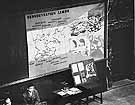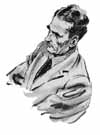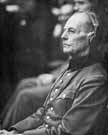
|
|
|

|

|

|

|
|
Click on an image to see a larger, more detailed picture.
|
|
|
|
|
| 1946: The Pursuit of Justice |

|
pg. 650 |

|
|
|
|
| |
 The Allied prosecutors made use of the extensive records left behind by the Hitler regime to convict its leaders at Nuremberg. Prosecutors provided massive documentary evidence to the court, which carried more weight than witness testimony. This photograph shows only a tiny portion of the physical evidence presented. Pictured are a map, some photographs, and a few artifacts suggestive of atrocities.
The Allied prosecutors made use of the extensive records left behind by the Hitler regime to convict its leaders at Nuremberg. Prosecutors provided massive documentary evidence to the court, which carried more weight than witness testimony. This photograph shows only a tiny portion of the physical evidence presented. Pictured are a map, some photographs, and a few artifacts suggestive of atrocities.
|
 Rudolf Hess was Hitler's secretary until being captured after flying to Great Britain on a self-appointed "peace mission" in 1941. At Nuremberg, he feigned insanity during much of the proceedings. He pretended that he was unaware of what was going on, had lost his memory, and was hence unfit to stand trial. Nuremberg courtroom artist Ed Vebell, on assignment for the U.S. Army newspaper Stars and Stripes, wrote: "Hess looked very hollow-cheeked and thin-necked. He seemed to ignore the proceedings and kept his head down--absorbed in a book." Hess was convicted of crimes against peace. The judges sentenced him to life in prison. He spent his remaining 43 years in Spandau Prison, and for the final 23 years he was the only prisoner in the institution. He committed suicide in 1987 at age 93.
Rudolf Hess was Hitler's secretary until being captured after flying to Great Britain on a self-appointed "peace mission" in 1941. At Nuremberg, he feigned insanity during much of the proceedings. He pretended that he was unaware of what was going on, had lost his memory, and was hence unfit to stand trial. Nuremberg courtroom artist Ed Vebell, on assignment for the U.S. Army newspaper Stars and Stripes, wrote: "Hess looked very hollow-cheeked and thin-necked. He seemed to ignore the proceedings and kept his head down--absorbed in a book." Hess was convicted of crimes against peace. The judges sentenced him to life in prison. He spent his remaining 43 years in Spandau Prison, and for the final 23 years he was the only prisoner in the institution. He committed suicide in 1987 at age 93.
Photo: Ed Vebell
|
 Wilhelm Keitel
Wilhelm Keitel
Wilhelm Keitel was the chief of staff of the High Command of the German Armed Forces from 1938 until the collapse of the Nazi empire. His complete subservience to Hitler and willingness to condone mass murder are the primary reasons why Keitel was sentenced to death by the Nuremberg Tribunal in October 1946. A professional soldier who was wounded in the First World War, Keitel rose through the ranks during the 1920s and 1930s, and was appointed to the top position in the German military in February 1938. He assumed the rank of general field marshal in July 1940. Keitel's obsequious loyalty to Hitler and patent inability to criticize him influenced other officers to blindly obey the Führer. More disastrous, however, were Keitel's orders that sanctioned mass murder, most notoriously the deadly "Night and Fog" decree of December 1941.
|
|

|

|

|

|
 August 13, 1946: British authorities open detention camps on the island of Cyprus to hold Jewish refugees who have been prevented from entering Palestine due to British restrictions on immigration.
August 13, 1946: British authorities open detention camps on the island of Cyprus to hold Jewish refugees who have been prevented from entering Palestine due to British restrictions on immigration.
|
 September 1946: Paul Touvier, a former right-wing Vichy sympathizer and an adversary of French partisans, is sentenced to death in absentia for treason.
September 1946: Paul Touvier, a former right-wing Vichy sympathizer and an adversary of French partisans, is sentenced to death in absentia for treason.
|
 September 18, 1946: One portion of Emanuel Ringelblum's Warsaw Ghetto diary, which was secretly buried by Ringelblum, is discovered in a ruined house at 68 Nowolipki Street in Warsaw; See December 1, 1950.
September 18, 1946: One portion of Emanuel Ringelblum's Warsaw Ghetto diary, which was secretly buried by Ringelblum, is discovered in a ruined house at 68 Nowolipki Street in Warsaw; See December 1, 1950.
|
|
|
|
|
| 1946: The Pursuit of Justice |

|
pg. 650 |

|
|
The Holocaust Chronicle
© 2009 Publications International, Ltd.
|
|
